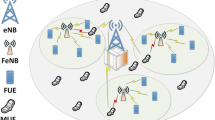Abstract
Femtocell is a promising technique to enhance indoor coverage and improve network capacity. Nevertheless, because of the random and co-channel deployment of femtocells, the macrocell will suffer serious cross-tier interference from femtocells in two-tier femtocell networks. Thus, interference mitigation in femtocell networks has been an indispensable task. Meanwhile, with the explosive popularity of smart terminals, especially smart phones and tablets, the wireless networks have loaded a mount of data services with diverse delay quality of service (QoS) requirements. However, due to the stochastically varying nature of wireless physical channel, it is extremely difficult to offer a deterministic delay guarantee in wireless networks. Therefore, the effective capacity of femtocell users (FU) has been introduced to provide a statistical delay QoS provisioning. For that reason, in this paper, we will study the interference mitigation with statistical delay QoS guarantee in uplink two-tier orthogonal frequency division multiple access (OFDMA) femtocell networks. In order to mitigate the cross-tier interference at macrocell base station (MBS), we adopt a price-based power control strategy, in which the MBS protects itself by pricing the interference from FU. Additionally, to guarantee the statistical delay QoS for each FU, effective capacity is introduced into their utility functions. Then, a Stackelberg game is formulated to study the joint utility maximization of the MBS and the FUs subject to a maximum tolerable interference power constraint at the MBS. Subsequently, based on the mathematical analysis of the equilibrium of the formulated Stalkeberg game, a particle swarm optimization (PSO) aided power allocation (PSOPA) algorithm is proposed to solve this optimization problem. At last, simulation results show that our proposed PSOPA algorithm can not only improve significantly the average effective capacity of each FU and guarantee their statistical delay QoS, but also converge successfully.









Similar content being viewed by others
References
(2014). Cisco, White Paper
Chandrasekhar V, Andrews J, Gatherer A (2008) IEEE Commun Mag 46(9):59. doi:10.1109/MCOM.2008.4623708
Andrews J, Claussen H, Dohler M, Rangan S, Reed M (2012) IEEE J Sel Areas Commun 30(3):497. doi:10.1109/JSAC.2012.120401
Bennis M, Perlaza S (2011). In: 2011 IEEE International Conference on Communications (ICC), pp 1–5. doi:10.1109/icc.2011.5962649
Lien SY, Tseng CC, Chen KC, Su CW (2010). In: 2010 IEEE International Conference on Communications (ICC), pp 1–6. doi:10.1109/ICC.2010.5502784
Sun Y, Jover R, Wang X (2012) IEEE Trans Wirel Commun 11(2):614. doi:10.1109/TWC.2011.120511.101794
Jo HS, Mun C, Moon J, Yook JG (2009) IEEE Trans Wirel Commun 8(10):4906. doi:10.1109/TWC.2009.080457
Saraydar C, Mandayam NB, Goodman D (2001) IEEE J Sel Areas Commun 19(10):1883. doi:10.1109/49.957304
Hou Y, Laurenson D (2010). In: 2010 IEEE 72nd Vehicular Technology Conference Fall (VTC 2010-Fall), pp 1–5. doi:10.1109/VETECF.2010.5594154
Erturk M, Aki H, Guvenc I, Arslan H (2010). In: 2010 IEEE Global Telecommunications Conference (GLOBECOM 2010), pp 1–6. doi:10.1109/GLOCOM.2010.5683397
Ellouze R, Gueroui M, Alimi A (2011). In: 2011 IEEE Wireless Communications and Networking Conference (WCNC), pp 84–89. doi:10.1109/WCNC.2011.5779111
Taleb T, Ksentini A (2012). In: 2012 IEEE International Conference on Communications (ICC), pp 5146–5150. doi:10.1109/ICC.2012.6364289
Lin S, Tian H (2013). In: 2013 IEEE Wireless Communications and Networking Conference (WCNC), pp 649–654. doi:10.1109/WCNC.2013.6554640
Tsiropoulou E, Katsinis G, Vamvakas P, Papavassiliou S (2013). In: 2013 IEEE 18th International Workshop on Computer Aided Modeling and Design of Communication Links and Networks (CAMAD), pp 104–108. doi:10.1109/CAMAD.2013.6708098
Wu D, Negi R (2003) IEEE Trans Wirel Commun 2(4):630. doi:10.1109/TWC.2003.814353
Tang J, Zhang X (2007) IEEE Trans Wirel Commun 6(12):4349. doi:10.1109/TWC.2007.06031
Qiao D, Gursoy M, Velipasalar S (2011) IEEE Trans Commun 59 (7):2006. doi:10.1109/TCOMM.2011.051311.090315
Xiong C, Li G, Liu Y, Chen Y, Xu S (2013) IEEE Trans Wirel Commun 12(6):3085. doi:10.1109/TWC.2013.050313.121695
Al Daoud A, Alpcan T, Agarwal S, Alanyali M (2008). In: 2008. CDC 2008. 47th IEEE Conference on Decision and Control, pp 1422–1427. doi:10.1109/CDC.2008.4738975
Economides AA, Silvester JA (1990). In: Proceedings 28th Annual Allerton Conference on Communications, Control and Computing, p 1990
Boyd S, Vandenberghe L (2004). In: Cambridge University Press
Saraydar C, Mandayam NB, Goodman D (2002) IEEE Trans Commun 50(2):291. doi:10.1109/26.983324
Kennedy J, Eberhart R (1995). In: IEEE International Conference on Neural Networks, 1995. Proceedings, vol 4, pp 1942–1948. doi:10.1109/ICNN.1995.488968
Shi Y, Eberhart R (1999). In: 1999. CEC 99. Proceedings of the 1999 Congress on Evolutionary Computation, vol 3, p 1950. doi:10.1109/CEC.1999.785511
Xie T, Zhang G, Xie J, Liu Y (2013). In: 2013 2nd International Symposium on Instrumentation and Measurement, Sensor Network and Automation (IMSNA), pp 489–493. doi:10.1109/IMSNA.2013.6743322
RAN4 G. In: R4-092042
Acknowledgements
This work was supported by The National Natural Science Foundation of China (61271179) and the fundamental research funds for the central universities (2013RC0110).
Author information
Authors and Affiliations
Corresponding author
Rights and permissions
About this article
Cite this article
He, S., Lu, Z., Wen, X. et al. A Pricing Power Control Scheme with Statistical Delay QoS Provisioning in Uplink of Two-tier OFDMA Femtocell Networks. Mobile Netw Appl 20, 413–423 (2015). https://doi.org/10.1007/s11036-015-0628-x
Published:
Issue Date:
DOI: https://doi.org/10.1007/s11036-015-0628-x




